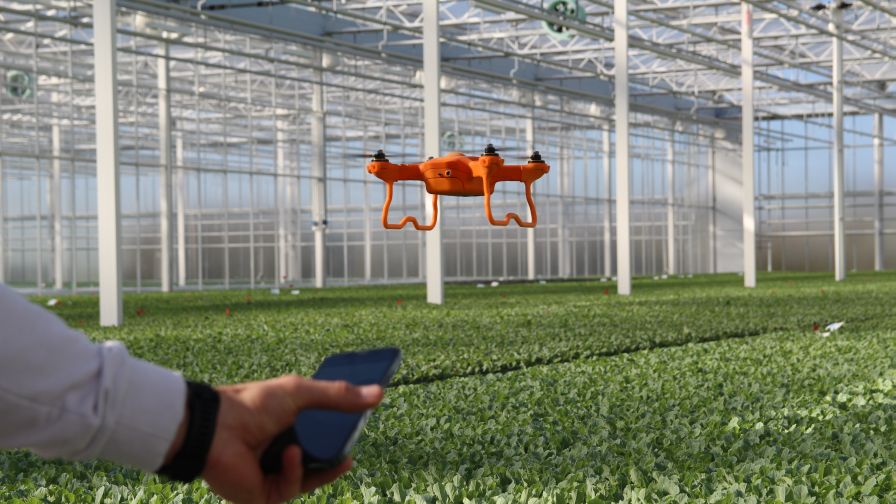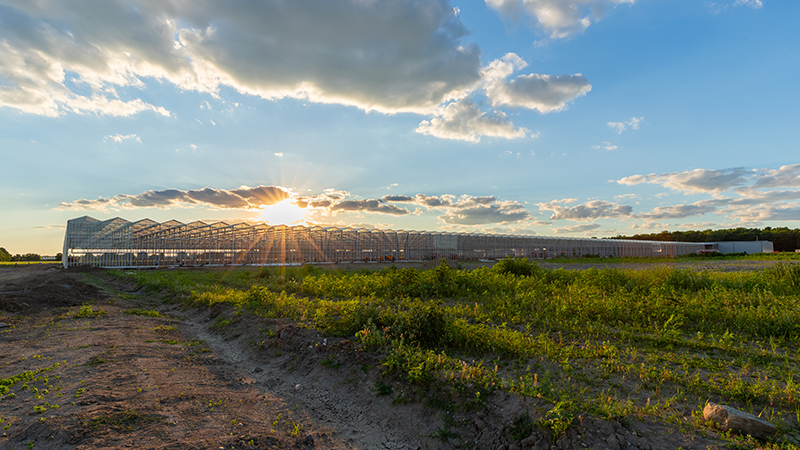How Drones Are Being Used in and Above the Greenhouse

Photo: Corvus Drones
De Drone, De Drone! Okay, maybe your staff won’t recreate the intro of Fantasy Island, but they will surely be intrigued. Drones in and above the greenhouse? While still a new use case, drone use in agriculture is expanding at a rapid pace. Advances in materials and battery technology, as well as onboard sensors, have created opportunities for drones to assist with pest scouting and control, crop monitoring, structural inspection of overhead components, marketing (think overhead photo and video for your website), and even application of greenhouse shading compounds.
Some agricultural drones weigh just over an ounce, while others are powerful enough to carry 40 liters of liquid for aerial applications. Some drones are flown by or with the supervision of a human pilot, while others flown indoors can be people-free. To make the process user-friendly, many companies now offer drones as a subscription service. The vendors take care of drone maintenance and repair.
The inside of a greenhouse is a tricky space to fly in. Expensive light fixtures, plants, wires, support posts, and other items would seem to be in the way. Images of plastic-crunching impacts and sweeping up pieces come to mind.
Frans-Peter Dechering is the co-founder of Corvus Drones. He explains how a drone could fly inside a greenhouse, where the GPS signal is often spotty, without hitting any posts or light fixtures.
“We have developed a drone which navigates by camera, so it’s not using GPS,” Dechering says. “We fly in the greenhouse fully automatic — you can deploy the drone from your office, schedule flights, and link tasks.”
Before this drone takes off for the first time, an initial accessibility check is performed, but the requirements aren’t much.
“We can fly in almost every greenhouse,” Dechering says. “We need 2 meters of space between the canopy and the first greenhouse obstacle. That’s it in most modern greenhouses, it’s no problem at all.”
Applying Greenhouse Shading
Applying shading compound usually takes some brave souls who are willing to crawl around on a glass roof, dragging heavy hoses. It can take hours or days, and there is real risk involved. Several companies, including AutoSpray Systems of the UK, are now using drones to apply the white stuff with no humans leaving the ground (your insurance agent will approve).
The drones not only carry the liquid into the air, they also precisely disperse it and track where they’ve been. When it’s time for a tank changeout, they return to the base station. An operator swaps tanks and batteries in a couple of minutes, and the drone flies back to begin again where it left off. Application times are faster than humans balancing on a glass roof, and shading application is more even, saving expense two ways.
Integrated Pest Management
Growers can use drones to monitor pests, apply biologics, and even hunt problem moths with killer drones. Some drones help you get rid of insects, others help you apply them.
When I heard about killer drones that hunt moths, I had to know more. Bram Tijmons is the CEO and co-founder of PATS Indoor Drone Solutions. He explains that from frustration with mosquitoes came the idea for small drones that target moths and terminate them mid-flight. He sees technology and biology working hand in hand to reduce insecticide use and control greenhouse pests.
“If you spray something, then you also kill all your beneficials that are eating your whiteflies,” Tijmons says.
Working together as a system, a permanently mounted 3-D camera and a small drone eliminate the pest moth.
“The camera is constantly updating its map and includes locations of upright poles, wires, plants, and other fixtures. An interception is a calculation made by the system and the drone together in real time,” Tijmons explains.
The PATS-X drone is guided by the PATS camera box, which flies the drone for the intercept. When given the command and instructions, the drone leaps from its charging pad and chases the moth with high-speed and high-G maneuvers. The trespassing insect meets its doom in the drone impellers, and then the drone returns to the pad. It happens fast.
“We need one and a half seconds for a chase,” Tijmons says.
By looking at moth size, flight characteristics, and other data, the system can distinguish between different species to avoid harming beneficial insects. It won’t bother a bumblebee, but recognizes harmful bugs.
“We make frameworks,” Tijmons says, “insect profiles, as we call them, and start monitoring them.”
The PATS-X drones are tiny, about 30 grams or one ounce, and fit in your hand. They are safe to fly around people, but you likely won’t see them in action — these drones hunt at night when the moths are active.
Parabug uses drones to apply beneficial insect treatments on crops. Developed for field applications, the Parabug team also helps nurseries with large outdoor ornamental crops.
“A lot of the time in ornamentals, your target pests are similar or the same, and they’re using generalist predators who might go after multiple pests in each of those,” says Jaclyn Bennett, General Manager at Parabug. “We do a lot of lacewing application with East Coast nurseries and then some of the predatory mites for thrips.”
Think of the drone as the delivery system, ensuring an even treatment over a wide area. Bennett explains the dispersion method as similar to a salt shaker. The container rotates in flight, maintaining a uniform distribution, and keeps the bugs gently mixed with the carrier material for even distribution.
Monitoring for Germination and Growth Problems
Large, inaccessible areas can be challenging for growers to monitor accurately, and new drone technology can assist with that.
“We do growth monitoring for all kinds of growers, and we recently launched the lettuce application suite, which starts from, let’s say, germination growth, size estimation, and also gutter alignment,” explains Dechering. The system can perform germination counts, monitor growth, and measure the exact leaf area index.
“Use case number one is gutter alignment because everyone has an issue with the gutter. When growing hydroponic lettuce, the gutters are sometimes misaligned and the plants are wilting,” he says. “We fly alongside the posts, monitor if the gutters are aligned, and if not, we send a text or email alert to the grower that in Bay XYZ between post 20 and 21, the gutter is not aligned.”
Saving labor, reducing chemical inputs, and enabling better data collection are all areas where drones are making an impact. With affordable solutions like that, it may not be long before you hear the buzz of drones in a greenhouse near you.








